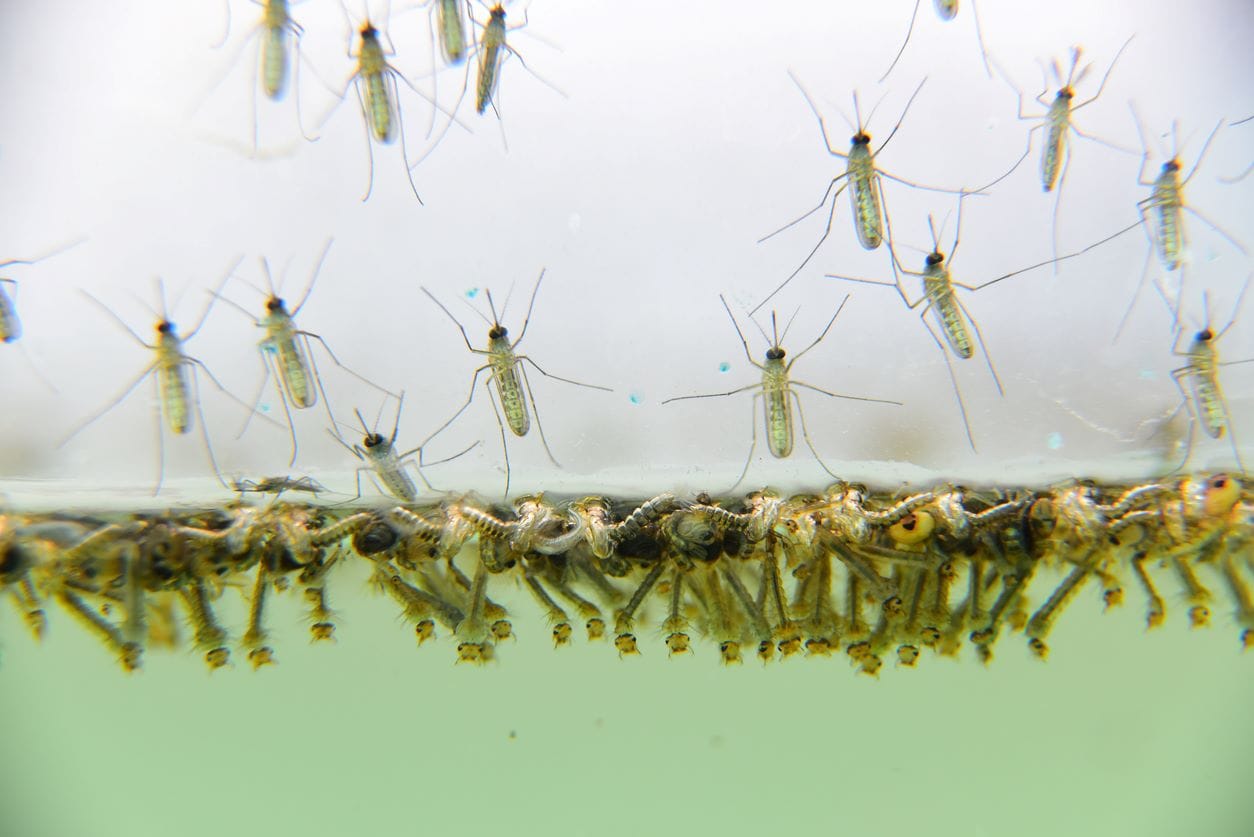
How long do mosquitoes live for before they keel over dead or get splattered prematurely by the host they decided to feed on?
As this article explains, the lifespan of a mosquito can last as little as only a few weeks up to several months. Knowing the lifecycle of a mosquito allows experienced exterminators to easily find and kill these pests. For you, knowing how long mosquitoes live and where they will breed is a vital step in finding these bloodsuckers and keeping them from selecting you as its next host.
What Is the Lifespan of a Mosquito?
Different species of mosquitoes have varying life expectancies. Some mosquitoes live for about a month, with half of that time spent in the egg and larva stage. These species of mosquitoes are the ones that will usually appear after a heavy rain, flood, or high tide. They are usually only around long enough to hatch, breed, feed, then die. Other species of mosquitoes can live 5 months at a time and reproduce several times during their life.
Lifecycle of a Mosquito
A mosquito has four stages in its life cycle that include the egg, larva, pupa, and adult phases.
Egg
Mosquitoes lay their eggs in groups as many as 400 on top of stagnating water in what looks like a raft of eggs. The mosquito will lay its eggs in the water because the early stages of a mosquito’s life requires them to be in water to survive.
Larva
When the weather is warm enough for the eggs to hatch, out comes the second stage of the mosquito’s life, the mosquito larvae. A mosquito larva (singular) is a small, white, and cylindrical creature that wriggles itself around feeding off the single-celled organisms around it in the water. The larvae still breathe oxygen through their tail end as they sit in the water. The larvae have to come up for air like a whale or dolphin.
Pupa
After six days to three weeks of being in the larva stage, they will enter into the next stage of life called the pupa stage. The mosquito pupa will float on the surface of the water and breathe through two little horns positioned on their head.
Adult
Once the pupa cracks open, the mosquito emerges as an adult and sits on the surface of the water waiting for its wings to dry out. Occasionally male adults will wait around for female pupa to mature and fertilize her eggs immediately. Once this happens, they are on the hunt for a blood-filled host to nourish her eggs.
How Long Do Female vs. Male Mosquitoes Live?
As you may have heard before, the female mosquitoes are the real blood suckers. A male mosquito could not bite you if he tried as they are not equipped with the long jabbing proboscis that females are.
The male mosquito feeds on the nectar of plants, lives only a few harmless weeks in the summer, and drops dead after he has fertilized the female’s eggs.
After the female’s eggs have been fertilized, she will either lay her eggs immediately or sleep all winter and lay her eggs the next spring. This is common among Culex pipiens, otherwise known as the house mosquito. These mosquitoes hide in attics and obscure places in order to get out of the deathly chill of winter.
Where Do Mosquitoes Breed?
Mosquitos need only a small amount of water to breed, so make sure that there are no instances of sitting water in or around your home. A puddle of water under a leaky sink can give a house mosquito enough space to lay its eggs. Although it is rare for a mosquito to lay its eggs inside your home, if it does happen, you might be in trouble.
When a mosquito is outdoors, their opportunity for a place to live increases tremendously. Any amount of stagnant water around your property can attract mosquitoes. The water is the natural home of the mosquito as they are aqueous insects in the first stages of life.
Do Mosquitoes Die When They Bite You?
Unlike bumble bees, mosquitoes do not die after they bite you. On the contrary, the mosquito needs a host to reproduce.
The mosquito draws blood from a host in order to provide its eggs with the protein and iron that they need to develop.
The only time a mosquito dies after biting you is when it is not sneaky enough to avoid the splattering force of a human hand.
How Long Do Mosquitoes Live After They Bite You?
When an adult female mosquito draws blood from a host, she is about to lay her eggs. The amount of time that a mosquito will live after biting you will depend on several things like the species of the mosquito and how long it has previously lived.
Different species of mosquitoes live longer than others and breed differently as well. Some species of mosquitoes will only breed once before dying, but others can breed multiple times over their life lasting several months.
How Long Can Mosquitoes Live Without Food or Blood?
As mentioned before, mosquitoes actually feed on the nectar of flowers during spring and summer months. The female mosquitoes only need a blood meal when they need the nutrients blood provides to their eggs. The female mosquito will search for a blood meal every two to three nights to nourish her eggs.
Mosquitoes are also known to go into a dormant state like hibernation during winter months which can last up to six months. A female mosquito may even feed before the winter and stay dormant during this six-month period waiting to lay her eggs the next spring or summer.
Mosquito Control With Clegg’s
Knowing the mosquito life cycle and all of its habits is an important factor in mosquito control. When you know where to look for pests and how they act in nature, it is much easier to track the insect you are attempting to exterminate.
Over at Clegg’s Pest Control, we are experts when it comes to the habits of mosquitoes. If you think that you may have a mosquito infestation on your property, we can check it out. The thing about our mosquito extermination services that our customers love is our free inspection. Before paying a penny, we will examine your situation and give you suggestions on what should be done. We guarantee that our professional advice will have your home and yard mosquito-free for the summer.

